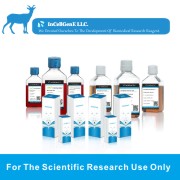

Overview
| Organism | Homo sapiens, human |
|---|---|
| Tissue | somatic cell hybrid |
| Cell Type | endothelial |
| Product Format | frozen |
| Morphology | endothelial |
| Culture Properties | adherent |
| Biosafety Level |
1
Biosafety classification is based on U.S. Public Health Service Guidelines, it is the responsibility of the customer to ensure that their facilities comply with biosafety regulations for their own country. |
| Applications |
Electron photomicrographs demonstrate cytoplasmic distribution of Weibel-Palade bodies and tissue-specific organelles, characteristics of differentiated endothelial cell functions such as angiogenesis, homeostasis/thrombosis, blood pressure and inflammation.
|
| Storage Conditions | liquid nitrogen vapor phase |
Properties
| Images |

|
|---|---|
| Derivation |
The human umbilical vein cell line, EA.hy926, was established by fusing primary human umbilical vein cells with a thioguanine-resistant clone of A549 by exposure to polyethylene glycol (PEG). Hybrid clones were selected in HAT medium and screened for factor VIII-related antigen.
|
| Antigen Expression |
Factor VIII-related antigen; Homo sapiens, expressed
|
| Genes Expressed |
Factor VIII-related antigen; Homo sapiens.
|
| Comments |
Electron photomicrographs demonstrate cytoplasmic distribution of Weibel-Palade bodies and tissue-specific organelles, characteristics of differentiated endothelial cell functions such as angiogenesis, homeostasis/thrombosis, blood pressure and inflammation. Ref Ref EA.hy926 cells have been maintained for more than 100 population doublings (PDLs). |
Background
| Complete Growth Medium |
The base medium for this cell line is ATCC-formulated Dulbecco''s Modified Eagle''s Medium, Catalog No. 30-2002. To make the complete growth medium, add the following components to the base medium: fetal bovine serum to a final concentration of 10%. |
|---|---|
| Subculturing |
Protocol: Volumes used in this protocol are for 75 sq cm flasks; proportionally reduce or increase amount of dissociation medium for culture vessels of other sizes. Corning® T-75 flasks (catalog #430641) are recommended for subculturing this product.
Interval: Twice a week
Subcultivation Ratio: A seeding density of 2 X 103 to 3 X 103viable cells/sq. cm should be used when subculturing these cells
Medium Renewal: Every 2 to 3 days
|
| Cryopreservation |
Freeze medium: Complete Growth medium, 95%; DMSO, 5%
Storage temperature: liquid nitrogen vapor phase
|
| Culture Conditions |
Atmosphere: air, 95%; carbon dioxide (CO2), 5%
Temperature: 37��C
|


